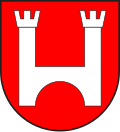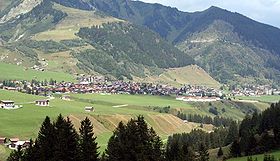Tujetsch
| Tujetsch | |
|---|---|
| State : |
|
| Canton : |
|
| Region : | Surselva |
| BFS no. : | 3986 |
| Postal code : | 7187 Camischolas 7188 Sedrun 7189 Rueras |
| Coordinates : | 701 597 / 171 093 |
| Height : | 1450 m above sea level M. |
| Height range : | 1226-3327 m above sea level M. |
| Area : | 133.91 km² |
| Residents: | 1238 (December 31, 2018) |
| Population density : | 9 inhabitants per km² |
| Website: | www.tujetsch.ch |
|
Sedrun |
|
| Location of the municipality | |
The Tujetsch ( , German Tavetsch ) is a political municipality in the Surselva region of the Swiss canton of Graubünden .
geography
The municipality is located in the Cadi on the Vorderrhein , extends from the Oberalp Pass to outside Bugnei, forms the westernmost part of the canton of Graubünden and borders the cantons of Uri and Ticino .
Tujetsch comprises the following eleven fractions (order down the valley): Tschamut, Selva, Dieni, Rueras, Zarcuns, Camischolas, Gonda, Sedrun , Bugnei, Surrein, Cavorgia .
The Tomasee (2345 m above sea level) is considered to be the source of the Vorderrhein (Rät. Rein anteriur). Of the glaciers in the municipality, the Maighels glacier is the largest.
The Maighelshütte and Berg Crispalt ( 3,076 m above sea level) are also located in the municipality .
coat of arms
Blazon : In red, a silver bridge fortified by two towers .
The community bears the coat of arms of the Pontaningen family . Abbot Peter von Pontaningen was the first to seal the federal letter of the Upper or Gray League .
history

Numerous megaliths and cup stones for orientation along the old mule paths indicate that the Tujetsch pass crossings were already important in prehistoric times. The wooded valley was cleared after the founding of the Disentis monastery in the 8th century and widely scattered farm settlements emerged. In the 12th century, the Walsers migrated over the Oberalp Pass and settled in the upper Tujetsch. It was not until the 18th century that the mountain farmers gradually moved down into the valley and formed individual villages. Sedrun, where the parish church was consecrated in 1205, became the main town of Tujetsch. There never was a village of Tujetsch.
The smallest breed of sheep in Switzerland, the Tavetsch sheep, comes from the Tujetsch . The animals, which died out in 1954 in the Lange Erlen zoo in Basel , resembled the small, robust sheep of the Neolithic Age , in which the female animals were also horned. Since 1984 the ProSpecieRara foundation has been backbringing tavetscher-like sheep with uncrossed stocks from Vrin and Medels .
population
| Population development | |||||||||||||
|---|---|---|---|---|---|---|---|---|---|---|---|---|---|
| year | 1718 | 1835 | 1850 | 1900 | 1950 | 1960 | 1980 | 2000 | 2003 | 2010 | 2012 | 2014 | 2016 |
| Residents | 832 | 1121 | 979 | 810 | 1122 | 1957 (power plant construction) | 1855 | 1525 | 1739 | 1732 | 1542 | 1359 | 1285 |
The population speaks the local Rhaeto-Romanic dialect, the Tuatschin . The written language is the idiom Sursilvan .
economy
The usable alpine area of 5650 ha, 700 ha of meadows and fields and 1351 ha of forest are worked by 70 employees in 34 agricultural and forestry companies. 211 employees work in 27 industrial and commercial enterprises and 374 employees in 78 service companies in the tourism sector (as of 2002).
The two reservoirs Lai da Nalps and Lai da Curnera are located in the municipality of Tujetsch . Water rates are an important source of income for the community.
tourism
One of the main sources of income for the population is winter and summer tourism. The systematic development of the ski area began in 1962 with the construction of the Dieni-Milez ski lifts.
The following 3000m peaks can be climbed from Tujetsch: Oberalpstock 3327 m, Kleiner Piz Tgietschen 3096 m, Piz Giuv 3096 m, Piz Crispalt 3076 m, Giufstöckli 3061 m, Piz Nair 3059 m, Piz Gannaretsch 3039 m, Piz Ault 3027 m, Piz Blas 3018 m, Witenalpstock 3016 m, Piz Rondadura 3015 m, Piz Uffiern 3013 m, Brichplanggenstock 3011 m, Piz Ravetsch 3007 m, Badus (Six Madun) 2928 m
The most important pass crossings on foot are the Bornengo Passo (2631 m) to Airolo, the Lolen Pass (2399 m) and Maighel Pass (2420) to Andermatt and the Chrüzli Pass (2347 m) to Bristen. The SAC huts Badus, Maighels, Etzli, Cavardiras and Cadlimo can be used as accommodation for hikes and mountain climbs.
The Senda Sursilvana , a long-distance hiking trail along the young Rhine , leads from the Oberalp Pass through the Tujetsch towards Chur.
traffic
The Furka-Oberalp-Bahn , since 2003 Matterhorn-Gotthard-Bahn , was used for the first time in 1925 on the entire route from Brig to Disentis . The railway is the only winter-safe connection to the west, the road over the Oberalp Pass is closed in winter.
The canton of Graubünden, the Surselva region and the municipality of Tujetsch decided on September 13, 2007 not to implement the Porta Alpina project. The Porta Alpina development association now intends to build the Sedrun stop in the new NEAT Gotthard tunnel on a private basis.
Attractions
- Catholic parish church St. Vigilius, in Sedrun
- Chapel of St. Nicholas
- Chapel of St. Anna, in Camischolas
Personalities
literature
- Greti Büchi: Megaliths in the Canton of Graubünden , self-published Forch 1996
- Adolf Collenberg: Tujetsch. In: Historical Lexicon of Switzerland . 2013 .
Web links
- Tujetsch on the ETHorama platform
- Official website of the Tujetsch community (romontsch / german)
- History of Tujetsch
Individual evidence
- ↑ Permanent and non-permanent resident population by year, canton, district, municipality, population type and gender (permanent resident population). In: bfs. admin.ch . Federal Statistical Office (FSO), August 31, 2019, accessed on December 22, 2019 .
- ↑ Tschamut on ETHorama
- ↑ Crispalt on ETHorama
- ↑ prospecierara.ch: Bündner Oberländer Schaf ProSpecieRara, accessed on December 24, 2015
- ↑ Hiking Switzerland on the Senda Sursilvana in Graubünden
- ^ Catholic parish church of St. Vigilius
- ↑ St. Nicholas Chapel
- ↑ St. Anna Chapel
- ↑ Paolo Dominici (Italian) in treccani.it/enciclopedia (accessed on: April 21, 2016.)
- ^ Mariusz Karpowicz: Artisti ticinesi in Polonia nel '600 . Stato del Cantone Ticino, Bellinzona 1983, pp. 66, 67, 68.









